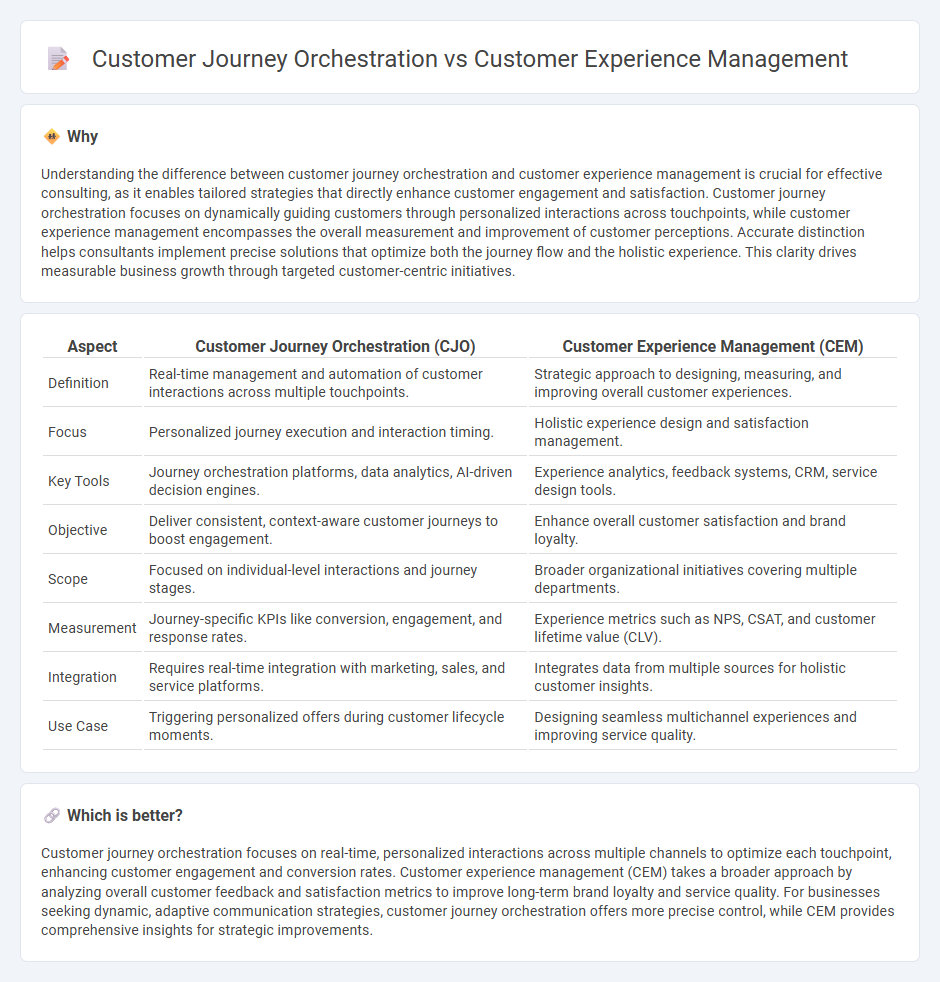
Customer Journey Orchestration focuses on real-time, personalized interactions across multiple touchpoints to optimize customer engagement and drive conversions. Customer Experience Management centers on analyzing feedback and behaviors to improve overall satisfaction and brand loyalty. Discover how integrating these strategies can transform your customer relationships and business growth.
Why it is important
Understanding the difference between customer journey orchestration and customer experience management is crucial for effective consulting, as it enables tailored strategies that directly enhance customer engagement and satisfaction. Customer journey orchestration focuses on dynamically guiding customers through personalized interactions across touchpoints, while customer experience management encompasses the overall measurement and improvement of customer perceptions. Accurate distinction helps consultants implement precise solutions that optimize both the journey flow and the holistic experience. This clarity drives measurable business growth through targeted customer-centric initiatives.
Comparison Table
| Aspect | Customer Journey Orchestration (CJO) | Customer Experience Management (CEM) |
|---|---|---|
| Definition | Real-time management and automation of customer interactions across multiple touchpoints. | Strategic approach to designing, measuring, and improving overall customer experiences. |
| Focus | Personalized journey execution and interaction timing. | Holistic experience design and satisfaction management. |
| Key Tools | Journey orchestration platforms, data analytics, AI-driven decision engines. | Experience analytics, feedback systems, CRM, service design tools. |
| Objective | Deliver consistent, context-aware customer journeys to boost engagement. | Enhance overall customer satisfaction and brand loyalty. |
| Scope | Focused on individual-level interactions and journey stages. | Broader organizational initiatives covering multiple departments. |
| Measurement | Journey-specific KPIs like conversion, engagement, and response rates. | Experience metrics such as NPS, CSAT, and customer lifetime value (CLV). |
| Integration | Requires real-time integration with marketing, sales, and service platforms. | Integrates data from multiple sources for holistic customer insights. |
| Use Case | Triggering personalized offers during customer lifecycle moments. | Designing seamless multichannel experiences and improving service quality. |
Which is better?
Customer journey orchestration focuses on real-time, personalized interactions across multiple channels to optimize each touchpoint, enhancing customer engagement and conversion rates. Customer experience management (CEM) takes a broader approach by analyzing overall customer feedback and satisfaction metrics to improve long-term brand loyalty and service quality. For businesses seeking dynamic, adaptive communication strategies, customer journey orchestration offers more precise control, while CEM provides comprehensive insights for strategic improvements.
Connection
Customer journey orchestration integrates real-time data and personalized interactions across multiple channels to deliver seamless customer experiences, directly enhancing customer experience management by aligning strategies with customer expectations. Effective orchestration enables businesses to anticipate needs, reduce friction points, and create consistent engagement that drives satisfaction and loyalty. By combining journey orchestration with experience management, companies gain comprehensive insights that optimize touchpoints and improve overall customer lifetime value.
Key Terms
**Customer Experience Management:**
Customer Experience Management (CEM) centers on capturing, analyzing, and enhancing customer interactions across all touchpoints to foster satisfaction and loyalty. It leverages data-driven insights and feedback to optimize service quality, personalize engagements, and resolve pain points efficiently. Discover how integrating advanced CEM strategies can transform your customer relationships and drive business growth.
Touchpoints
Customer experience management (CEM) centers on analyzing and improving overall interactions across multiple channels to enhance satisfaction and loyalty. Customer journey orchestration specifically targets the real-time coordination and optimization of touchpoints, ensuring seamless transitions and personalized engagements along the path to purchase. Explore how integrating both strategies can transform your customer touchpoints into strategic growth opportunities.
Feedback
Customer experience management (CEM) centers on capturing and analyzing customer feedback to enhance overall satisfaction and loyalty. Customer journey orchestration (CJO) leverages real-time feedback to dynamically tailor interactions across multiple touchpoints, ensuring personalized experiences. Explore how integrating feedback in both CEM and CJO drives superior customer engagement and business growth.
Source and External Links
What is customer experience management? - OpenText - Customer experience management (CXM) is the practice of designing and improving all customer interactions with a business, involving communications management, journey mapping, omnichannel messaging, voice of the customer, analytics, employee engagement, and technology integration for a holistic, customer-centric approach.
What is Customer Experience Management (CXM)? Ultimate Guide - CXM is a strategy centered on marketing, sales, and customer support that drives brand loyalty and repeat business by managing customer sentiment, personalizing content, creating customer personas, evaluating touchpoints, and investing in loyalty programs.
Customer Experience Management Guide for 2025 - Sprinklr - Effective CXM requires understanding customer preferences through data collection, segmenting audiences based on detailed criteria including psychographics, and addressing challenges like departmental silos and technology integration to deliver tailored, meaningful customer interactions.
 dowidth.com
dowidth.com